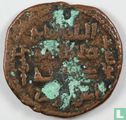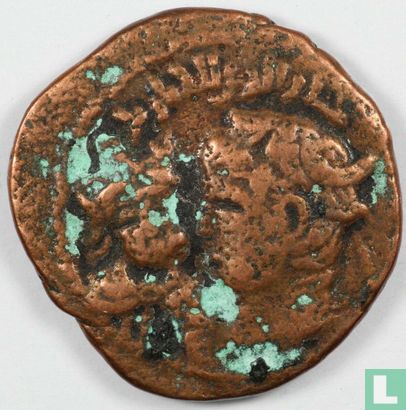

Enlarge image


Catalogue information
LastDodo number
8350361
Area
Coins
Title
Artuqids of Mardin AE32 dirham (Husam al-Din Yuluq Arslan of the Artuqids of Mardin, 580-597 AH) 1184-1201
Country
Face value
Year
1190
Variety / overstrike
Type
Designer
Series
Theme
Material
Weight
11.4
Diameter
32
Thickness
Punch
Shape
Obverse
( Nasir al-Din )
Reverse
( Ayyubid overlord al-Kamil Muhammad )
Edge
Privy mark
Mint mark
Number produced
Krause and Mishler number
Catalogue number
Ref: S/S 34; Poole 47; BMC 405-408; Edhem 47-52; Butak 31; Artuk 1224; Mitchiner 1035-1036 BW Ref: 002 047 154; Album 1829.2, Edhem 50
Details
Obv; Large diademed Roman-style male head on the right, facing left; smaller crowned Byzantine-style bust facing forward wearing cloak.
Legend in late Kufic in an arc above, from 2 to 11 o'clock, bearing the ruler's personal laqab and the title Malik Diyarbakr; all within a beaded circle.
Rev: Four line legend in late Kufic, continuing in left and right fields, containing obsequious tribute to Saladin, Yuluq Arslan's Ayyubid overlord, with Saladin's names, four honorific titles, and pedigree: al-Malik al Nasir Salah al-Din Muhiyy dawla (sic) Amir al-mu'minin Yusuf bin Ayyub.
Artuqid: Turkmen dynasty that ruled the province of Diyarbakir in northern Iraq (now in southeastern Turkey) through two branches: at Hisn Kayfa and Amid (1098–1232) and at Mardin and Mayyafariqin (1104–1408).
Artuq ibn Ekseb, founder of the dynasty, was rewarded for his services to the Seljuq sultan with the grant of Palestine in 1086. Forced out of Palestine by the Fatimids of Egypt, Artuq's descendant Mu’in ad-Din Sokmen returned to Diyarbakir, where he took Hisn Kayfa (1102), Mardin, and several other northern districts. His brother Najm ad-Din Ilghazi, meanwhile, returned to Seljuq service and was made governor of Iraq by the Seljuq sultan Muhammad. Sent to Diyarbakir in about 1107, Ilghazi displaced one of Sokmen's sons at Mardin (1108); he then made it the capital of his line, leaving Hisn Kayfa to his brother's descendants.
The Artuqids' relations with the Seljuqs thenceforth steadily worsened. Ilghazi organized a Turkmen coalition against the Seljuq governor of Mosul and was able to win control of all Diyarbakir by 1118. The next year he defeated European crusaders who were threatening Aleppo. From 1113 the Artuqids also expanded into the northeast, along the eastern Euphrates.
The rise of the Zangids in Mosul and later in Aleppo during the reigns of Da’ud (c. 1109–44) and his successor, Kara Arslan (1144–67), ended Artuqid expansion. The Artuqids were instead drawn into wars against the crusaders and the Byzantines by the Zangid Nureddin and, at his death in 1174, found themselves Zangid vassals. Their position in Diyarbakir weakened further as Saladin, ruler of Egypt, gradually began to reconquer Nureddin's old kingdom, and by 1186 the Artuqids had submitted to Saladin.
The Artuqids survived in Diyarbakir for two more centuries as vassals of the Seljuqs of Rum and the Khwarezm-Shahs. In 1232 the Artuqid line in Hisn Kayfa was destroyed by the Seljuqs; but the Mardin branch continued under the Mongols until 1408, when it was finally displaced by the Turkmen federation of the Kara Koyunlu.
The dynasty was founded by Artuk Bey, son of Eksük, a general originally under Malik Shah I and then under the Seljuq emir of Damascus, Tutush I. Tutush appointed Artuq governor of Jerusalem in 1086. Artuq died in 1091, and his sons Sökmen and Ilghazi were expelled from Jerusalem by the Fatimid vizier al-Afdal Shahanshah in 1098; the Fatimids lost the city to the crusaders the following year.
Sokman and Ilghazi set themselves up in Diyarbakır, Mardin, and Hasankeyf in the Jezirah, where they came into conflict with the sultanate of Great Seljuq. Sokman, bey of Mardin, defeated the crusaders at the Battle of Harran in 1104. Ilghazi succeeded Sokman in Mardin and imposed his control over Aleppo at the request of the qadi Ibn al-Khashshab in 1118. In 1119 Ilgazi defeated the crusader Principality of Antioch at the Battle of Ager Sanguinis.
In 1121 a Seljuq-Artuqid alliance, commanded by Mehmed I of Great Seljuq and Ilghazi, was defeated by the Kingdom of Georgia at the Battle of Didgori. Ilghazi died in 1122, and although his nephew Balak nominally controlled Aleppo, the city was really controlled by Ibn al-Khashshab. Al-Kashshab was assassinated in 1125, and Aleppo fell under the control of Zengi of Mosul. After the death of Balak, the Artuqids were split between Harput, Hasankeyf and Mardin. Sokman's son Davud, bey of Hasankeyf, died in 1144, and was succeeded by his son Kara Aslan. Kara Aslan allied with Joscelin II of Edessa against the Zengids, and while Joscelin was away in 1144, Zengi recaptured Edessa, the first of the Crusader states to fall (see Siege of Edessa). Hasankeyf became a vassal of Zengi as well.
Kara Aslan's son Nur ad-Din Muhammad allied with the Ayyubid sultan Saladin against the Sultan of Rum Kilij Arslan II, whose daughter had married Nur ad-Din Muhammad. In the peace settlement with Kilij Arslan, Saladin gained control of the Artuqid territory, even though the Artuqids were still technically vassals of Mosul, which Saladin did not yet control. With Artuqid support, however, Saladin eventually took control of Mosul as well.
The Artuklu dynasty remained in nominal command of upper Mesopotamia, but their power declined under Ayyubid rule.



